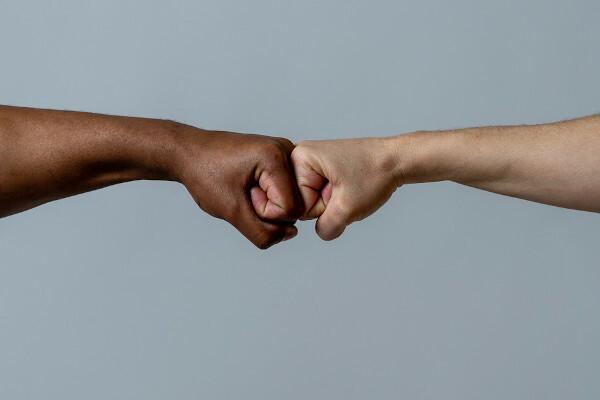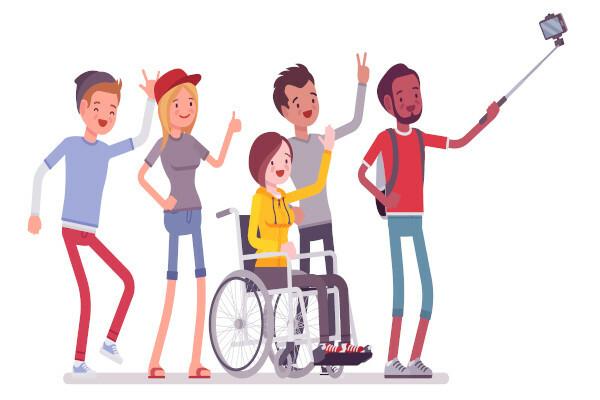Social inclusion is the act of including in the society categories of people historically excluded from the socialization process, such as black people, indigenous people, people with special needs, homosexuals, transvestites and transgender people, as well as those in a situation of socioeconomic vulnerability, such as homeless people and low-income people income.
When talking about inclusion, we agree with the Universal Declaration of Human Rights and also with the Federal Constitution of 1988, which present rights that must be extended to all people, without exception. It is worth mentioning that societies that present high levels of social exclusion also face numerous other problems, such as the increase in crime and poverty rates.
Read too: secular state: guarantee of freedom of belief
What is social inclusion?
At Sociology, we say that social inclusion is a measure of social control, that is, it acts as means of integration between public administration and society in order to resolve conflicts and solve problems resulting from the formation of capitalist society.
Historically, some social groups were left out of the socialization process, not having proper access to rights such as education, decent employment, housing, health and adequate food. To solve this problem, governments started to create, from the 20th century, measures for the inclusion of the marginalized strata of the population in society.

To define social inclusion more precisely, we can also turn to the pioneer and one of the greatest scholars of social inclusion in Brazil, the social worker Romeo Kazumi Sassaki. He says that social inclusion it is "a bilateral process in which people who are still excluded and society seek, in partnership, to solve problems, decide on solutions and effect the equalization of opportunities for all."|1|
Groups most affected by social exclusion
If we analyze the formation of contemporary Western capitalist societies, we will see that these societies were established from colonization and enslavement. In this process led by European countries, social groups were left on the margins of society formed in the colonies.
These groups are, in general, blacks of African origin and natives of colonized lands – in the case of the Americas, indigenous peoples. As a result of the marginalization of these peoples and ideologies racists predominant in the colonization processes, which still persist today, there was and still is the exclusion of these categories from the process of formation of society. Thus, social inclusion measures aim to integrate these vulnerable groups into society, guaranteeing their rights.
Physically and mentally handicapped people, people with neurological comorbidities and people with special needs, in general, were also, for a long time, excluded from society because of their limitations.. For a long time, people thought about the urbanization, in leisure, education and sport aimed only at people who do not have mobility limitations or cognitive development.
People with physical disabilities, for example, could not and, in many cases, still cannot safely walk on the street or access public spaces for there are no instruments in these places that enable their inclusion, such as guides for the visually impaired or ramps for wheelchair access to places with stairs.

At people living with neurological problems that cause some kind of cognitive delay were also, for a long time, excluded from the right to school education. In the past, families kept these people at home, as there were no adapted schools to receive them, which resulted in further delay and deprivation of education and social interaction with other people, leading to a situation of non-development of skills that could be developed if these people were included in the school.
For a long time, the homosexuality and transsexuality they were considered sinful forms of degeneration of the subject, being even prohibited by the legal systems of some countries. The result of this was the marginalization of homosexuals and transsexuals, which can still be observed in Brazil, especially in relation to transgender people and transvestites.
These people suffer prejudice at school, which leads to school dropouts, and also in the business market. Without a job and without education, many transvestites and transsexuals enter into prostitution as the only way to survive and end up leading a life of suffering and social exclusion.
In case of low-income people, there is a need to integrate these people to basic services guaranteed, constitutionally, to all people, without restrictions of social class, gender, sexuality, religion or skin color. These rights are health care, adequate food, decent housing, education and employment.
The problem is that, historically, low-income populations do not access quality basic services. The public education and health service offered in urban centers, for example, is precarious, which places these people at a disadvantage compared to those who can pay for private services.
In isolated rural communities or in small towns, the problem is much greater because, often, nor are there hospitals and public schools that can satisfactorily serve low-income populations. income.
See too: Democracy - form of government in which the people participate directly or indirectly
Social Inclusion and Human Rights
The main justification for promoting the social inclusion of marginalized categories is in the the fact that there is a universal and indistinct category of rights that must meet all people. We are talking aboutHuman rights.
In 1948, three years after the end of Second World War and in order to prevent another genocide like the Holocaust, the UN promulgated a letter called Universal Declaration of Human Rights, which indicates that every human person, regardless of origin, political opinion, religious belief, social class or color, must have their basic rights fulfilled.
THE Constitution of the Federative Republic of Brazil 1988 is a document that aligns with the Universal Declaration of Human Rights to establish, at least legally, the need to include the marginalized categories of society in the full exercise of their rights. The problem is that a lot needs to be done for these rights to be guaranteed.
Consequences of the absence of inclusion measures
Sociologically speaking, the need to think about social control is due to the fact that social inequality and the marginalization of people is a delay factor for societies. When a society has a high rate of social exclusion, the Human Development Index (HDI) of this society is harmed.
There is also a calculation index, called the Gini Coefficient, which measures the inequality Social of a country. The greater the exclusion of certain categories, others being privileged, the greater the social inequality. O Gini index is displayed on a number ranging from 0 to 1. The closer to 0, the less unequal the society, the closer to 1, the greater the social inequality index. O Gini Coefficient it is also one of the factors influencing the HDI of a location.
The lower the HDI, the higher the poverty and social exclusion index, and the more poverty and social exclusion, the higher the violence indexes. When there is no education, employment, income, housing and adequate food, the greater the revolt and the lower the expectation of social growth.
These factors lead people to see crime as the only way out for their survival, which makes more violent societies and more corrupted by crime. Therefore, social control measures aimed at including marginalized categories of the population in the full guarantee of rights are beneficial to society as a whole.
Also access: Moral values and their importance to society
social inclusion at school
Paragraph 1 of article 58 of the Law 9,394/1996, known as the Law of Guidelines and Bases of Brazilian Education, says that, if there is a need for equip the public school to serve people with disabilities., the government must do it. This was a first step taken in the 1990s to promote social inclusion within the school, but it was not yet a step that would solve the problem.
Paragraph 2 of the article 227 of the Federal Constitution of 1988 also speaks of the obligation to have accessibility for the disabled in public buildings and on public transport. In relation to the school, what changed in the 2000s is that all public buildings must be suitable for the use of wheelchairs and other mobility difficulties, and there is also the inclusion of people with cognitive delays and mental disabilities in schools regular.

Before 1988 Constitution, there was no obligation for educational institutions, both private and public, to accept students with disabilities. The obligation to private educational institutions only occurred with the enactment of Law 13,146/2015, called Brazilian Inclusion Law.
According to this law, all educational institutions, private, public or associated, must adapt to to receive students with any type of disability and ensure their maintenance and effective learning. In this law, the inclusion of mentally handicapped people, people with cognitive delay and people with disorders that make learning difficult, such as Attention Deficit Hyperactivity Disorder (ADHD), Oppositional Defiant Disorder (TOD) and dyslexia, must be guaranteed.
The problem that public and private educational institutions still face is how to ensure learning and inclusion of these people in the school environment, since it takes much more than the simple adjustment of the physical space, being necessary The hiring specialized staff for the care and inclusion of these children.
For the inclusion to be effective, a interdisciplinary team involving psychologists, educational psychologists and social workers. In addition teacher training it must contemplate the effective service and teaching of people with disabilities.
Examples of social inclusion
Quotas in public universities and public examinations for blacks and indigenous people from public schools and for students from public schools in general;
Inclusion of disabled people or people with cognitive delays in regular schools;
Social assistance programs for low-income people and people in situations of social vulnerability, such as homeless people;
Professional training programs for young people from needy families;
Psychosocial assistance and professionalization programs for homosexuals, transsexuals and transvestites;
Accessibility for people with special needs, such as blind, deaf and wheelchair users, in public spaces or collective spaces managed by the private sector, in addition to accessibility on sidewalks and walkways on the sidewalk public.
Grades
|1| SASSAKI, R. K. Inclusion: building a society for all. Rio de Janeiro, Editora WVA, 1997, p. 41.
by Francisco Porfirio
sociology professor
Source: Brazil School - https://brasilescola.uol.com.br/educacao/inclusao-social.htm


